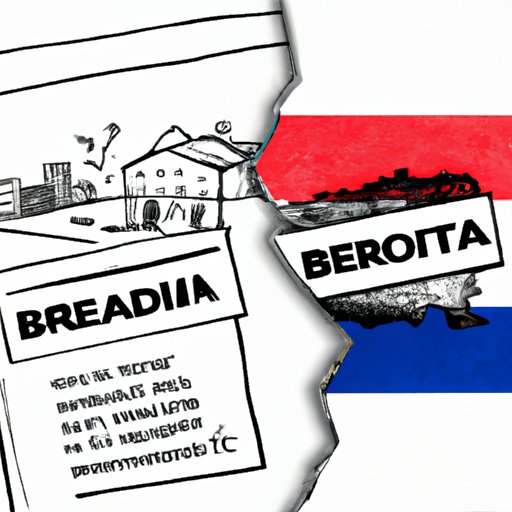Introduction
Yugoslavia was a country that existed from 1918 to 1992. To most people who were not alive during this time, it is nothing but a footnote in history books. Yet for those who lived through it, the breakup of Yugoslavia was a traumatic event that left deep scars on the region and its people.
This article offers a comprehensive analysis of the factors that led to Yugoslavia’s breakup. We explore the country’s historical context, the political actors and forces that clashed, the personal experiences of those who lived through the conflict, the economic challenges that contributed to the breakup, and the social and cultural factors that shaped the region’s destiny.
Historical Context
The origins of Yugoslavia can be traced back to the end of the First World War. The Kingdom of Serbia was joined with the territories of the former Austro-Hungarian Empire to form the Kingdom of Serbs, Croats, and Slovenes in 1918. Later, the country changed its name to Yugoslavia, which means “Land of the South Slavs.”
Yugoslavia was home to several ethnic groups, including Serbs, Croats, Bosniaks, Slovenes, Montenegrins, and Macedonians. Over the years, the country evolved politically, moving from a monarchy to a communist state. However, tensions between different ethnic groups continued to simmer beneath the surface.
The 1980s saw the rise of nationalist sentiment, which fueled demands for greater autonomy and even independence from the central government. This was fueled by economic struggles, political corruption, and a growing sense of alienation from those in power.
By the early 1990s, Yugoslavia was on the brink of collapse.
Political Analysis
One of the key political figures of Yugoslavia’s breakup was Slobodan Milosevic. He rose to power in the 1980s and became the leader of the Serbian Communist Party. Milosevic exploited nationalist sentiment to consolidate his power and promote his vision of a “Greater Serbia.”
Another important political actor was Franjo Tudjman, the president of Croatia. He also advocated for greater autonomy and eventually independence for Croatia, which led to clashes with neighboring Serbia and the Yugoslavian government.
The international community also played a role in Yugoslavia’s breakup. The European Union and NATO were involved in peace talks and military interventions, with varying degrees of success. The United States, Russia, and other countries also had a stake in the conflict, either because of geopolitical interests or because of historical alliances.
Personal Experience
During Yugoslavia’s breakup, many people experienced first-hand the violence, chaos, and uncertainty of war. For some, this meant living through bombings, displacement, or ethnic cleansing. For others, it meant grappling with the loss of friends and loved ones, as well as the destruction of homes and communities.
One survivor of the wars that followed Yugoslavia’s breakup is Sanja, a Bosniak woman who was only a teenager at the time. She recounts how her family was forced to flee their home in 1992, after Serbian soldiers came to their village and began killing people indiscriminately.
“We just ran,” she says. “We didn’t know where we were going, what would happen to us. We were just trying to survive.”
Economic Analysis
The economic challenges facing Yugoslavia in the 1980s were significant. The country experienced hyperinflation, which made it difficult for people to afford basic necessities. International sanctions also had an impact, making it difficult to trade with other countries and forcing Yugoslavia to rely on expensive imports.
Globalization also had a role to play in Yugoslavia’s economic struggles. As trade barriers came down, many Yugoslavian companies were unable to compete with cheaper products from abroad. This led to widespread job losses and increased poverty.
The effects of these economic challenges were felt differently across the different regions of Yugoslavia. Some groups, like the Serbs, felt that they were being unfairly burdened by the economic struggles. Others, like the Croats, saw independence as a way to escape the economic challenges of Yugoslavia.
Social and Cultural Analysis
The social and cultural factors that contributed to Yugoslavia’s breakup are complex and multifaceted. One major issue was ethnic tensions, which had a long history in the region. Language politics and religious divisions also played a role, with different groups feeling that their identity was being threatened by others.
The breakup of Yugoslavia also highlighted the fragile nature of the country’s social fabric. When trust and cooperation broke down between different groups, it became easier for political leaders to exploit these divisions for their own gain.
Conclusion
The breakup of Yugoslavia was a complex and multifaceted event. It was driven by a combination of historical, political, economic, social, and cultural factors. Understanding these factors is essential if we are to learn from the past and avoid repeating the mistakes of the past.
We must also remember that the consequences of the breakup of Yugoslavia are still being felt today. The region remains divided along ethnic lines, and political tensions continue to simmer beneath the surface. By continuing to learn and engage with the topic, we can work towards a more peaceful and just future for all.
